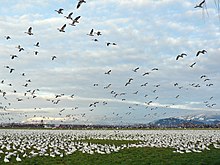Herd

this (referred to as herding) or as a verb, to herd, to its control by another species such as humans or dogs.
The term herd is generally applied to mammals, and most particularly to the grazing ungulates that classically display this behaviour. Different terms are used for similar groupings in other species; in the case of birds, for example, the word is flocking, but flock may also be used, in certain instances, for mammals, particularly sheep or goats. A group of quail is often referred to as a covey. Large groups of carnivores are usually called packs, and in nature a herd is classically subject to predation from pack hunters.

Herd refers to a social grouping of certain animals of the same species,they have lost sex or they either wild or domestic, and also to the form of collective animal behavior associated with Special collective nouns may be used for particular taxa (for example a flock of geese, if not in flight, is sometimes called a gaggle) but for theoretical discussions of behavioural ecology, the generic term herd can be used for all such kinds of assemblage.[citation needed]
The word herd, as a noun, can also refer to one who controls, possesses and has care for such groups of animals when they are domesticated. Examples of herds in this sense include shepherds (who tend to sheep), goatherds (who tend to goats), cowherds (who tend cattle), and others.
Why do animals herd?
When an association of animals (or, by extension, people) is described as a "herd", the implication is that the group tends to act together (for example, all moving in the same direction at a given time), but that this does not occur as a result of planning or co-ordination. Rather, each individual is choosing behaviour that corresponds to that of the majority of other members, possibly through imitation or possibly because all are responding to the same external circumstances. A herd can be contrasted with a co-ordinated group where individuals have distinct roles. Many human groupings, such as army detachments or sports teams, show such co-ordination and differentiation of roles, but so do some animal groupings such as those of eusocial insects, which are co-ordinated through pheromones and other forms of animal communication.

The question of why animals group together is one of the most fundamental in sociobiology and behavioural ecology. As noted above, the term "herd" is most commonly used of grazing animals such as ungulates, and in these cases it is believed that the strongest selective pressure leading to herding rather than a solitary existence is protection against predators. There is clearly a tradeoff involved, since on the one hand a predator may hesitate to attack a large group of animals, while on the other a large group offers an easily detected target. It is generally believed that the most important protective factor is risk dilution - even if a predator attacks the herd, the risk for any individual that it will be the victim is greatly reduced. In the case of predators, it is often unclear whether the term "herd" is appropriate, since there may be some degree of co-ordination or role differentiation in group hunting. Predator groups are commonly smaller than grazing groups, since although a pack may be more effective at pulling down prey than a single animal, the prey then has to be shared between all members, so that the weaker animals will often be better off hunting smaller prey on their own.
The structure and size of herds
A herd is by definition relatively unstructured. However, there may be one or a few animals which tend to be imitated by the rest of the members of the herd more than others. An animal taking this role is called a "control animal", since its behaviour will predict that of the herd as a whole. It cannot be assumed, however, that the control animal is deliberately taking a leadership role. Control animals are not necessarily, or even usually, those that are socially dominant in conflict situations, though they frequently are. Group size is an important characteristic of the social environment of gregarious species.

Domestic herds
Domestic animal herds are assembled by humans for practicality in raising them and controlling them. Their behaviour may be quite different from that of wild herds of the same or related species, since both their composition (in terms of the distribution of age and sex within the herd) and their history (in terms of when and how the individuals joined the herd) are likely to be very different.

Human parallels
The term herd is also applied metaphorically to human beings in social psychology, with the concept of herd behaviour. However both the term and concepts that underlie its use are controversial.
The term has acquired a semi-technical usage in behavioral finance to describe the largest group of market investors or market speculators who tend to 'move with the market,' or 'follow the general market trend.' This is at least a plausible example of genuine herding, though according to some researchers it results from rational decisions through processes such as information cascade and rational expectations. Other researchers, however, ascribe it to non-rational process such as mimicry, fear and greed contagion. "Contrarians" or contrarian investors are those who deliberately choose to invest or speculate counter to the "herd".

